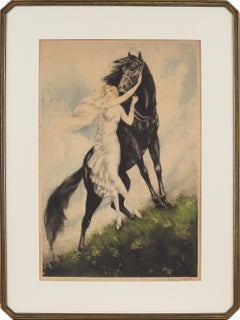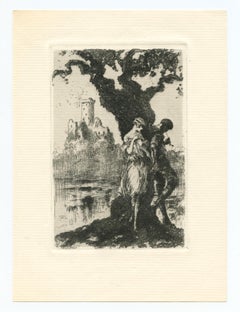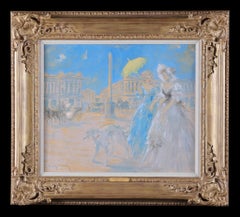Louis Icart Art
Louis Icart is considered to be a symbol of the Art Deco movement through his brilliant sketches and prints.
Born in 1888 in Toulouse, France, Icart’s interest in art began at an early age. He was particularly drawn to fashion sketches and designs during the period when the fashion industry was undergoing a revolution from conservative 19th-century designs to the clingy simplicity of the early 20th century.
Icart worked in major fashion studios where his "L.I." initials on women’s clothing were highly regarded. While fighting in World War I, he continued to sketch on every available surface to ward off the anguish and agony of the war. He moved to Paris after the war to concentrate on painting and produced beautiful etchings. Icart’s prints were elaborate aquatints and drypoints done with great skill. They often portrayed women in sensual, erotic poses with an implication of direct sexuality.
By the 1920s, the Art Deco movement had gained great popularity in Paris, France. Icart’s etchings and paintings, though largely influenced by Impressionists such as Claude Monet, were synonymous with the Art Deco era. His drawings also reflected the brilliance of Symbolists such as Gustave Moreau; however, Icart preferred not to be identified with artistic movements.
Icart’s financial and artistic success came in the late 1920s. His work was featured in fashion publications and design studios in Europe and the United States. His immensely popular images, which were considered phenomenal by 1925, included Laziness and Spilled Milk. Icart died on December 20, 1950, at his home in Montmartre, France.
Find original Louis Icart prints and other art on 1stDibs.
(Biography provided by Rosenbaum Contemporary)
Early 20th Century Modern Louis Icart Art
Etching
1930s Art Deco Louis Icart Art
Paper, Pencil, Aquatint
1920s Louis Icart Art
Etching
1920s Art Nouveau Louis Icart Art
Etching
Early 20th Century Art Deco Louis Icart Art
Oil
1920s Art Deco Louis Icart Art
Etching, Aquatint
Early 20th Century Modern Louis Icart Art
Etching
1920s Art Nouveau Louis Icart Art
Etching
Early 20th Century Modern Louis Icart Art
Etching
20th Century Louis Icart Art
Photographic Paper
Early 20th Century Modern Louis Icart Art
Etching
Early 20th Century Art Deco Louis Icart Art
Etching
1920s Louis Icart Art
Etching
1920s Louis Icart Art
Paper
20th Century Louis Icart Art
Etching
1920s Louis Icart Art
Etching, Aquatint
1930s Louis Icart Art
Canvas
1920s Art Deco Louis Icart Art
Engraving, Aquatint
Early 20th Century Art Deco Louis Icart Art
Etching
Early 20th Century Art Deco Louis Icart Art
Etching
1920s Louis Icart Art
Etching
1940s Louis Icart Art
Drypoint, Etching
20th Century Louis Icart Art
Photographic Paper
Early 20th Century Art Deco Louis Icart Art
Etching
20th Century Louis Icart Art
Photographic Paper
1920s Louis Icart Art
Etching
1920s Louis Icart Art
Etching
20th Century Louis Icart Art
Lithograph
1920s Art Deco Louis Icart Art
Etching, Paper
1930s Art Deco Louis Icart Art
Paper
1930s French School Louis Icart Art
Lithograph
Louis Icart art for sale on 1stDibs.
Artists Similar to Louis Icart
- 1stDibs ExpertAugust 15, 2024To tell if an Icart is an original, first examine the paper. The French artist's etchings were made on woven paper, so you can expect an original to have a textured surface and matte appearance. If the paper is smooth or glossy, it is likely contemporary, making the print a reproduction. Next, compare the details of the image to information about the etching that appears on trusted online resources or in a printed catalogue raisonné.
The size of the actual image that appears on your print should be within one-quarter inch of the dimensions stated in an online or printed catalog, and the copyright and publisher's information should match. Margin size can also help you identify Icart prints. On originals, the margin around the image is typically around three inches in width. Narrow margins may indicate a later reproduction. Because there are many convincing copies, you may wish to have a knowledgeable art dealer or certified appraiser authenticate your piece.
On 1stDibs, explore a variety of Louis Icart prints. - 1stDibs ExpertOctober 15, 2024To know if an Icart print is real, look closely at the paper. Genuine original Icart prints will usually be on woven paper with a textured, matte surface. If your print is smooth and glossy, it's likely a later reprint. You can also look up information about your print in trusted online resources or a printed catalogue raisonné. A real Icart print should be within one-quarter inch of the listed dimensions and have the same copyright and publisher information on the front or back. Also, examine the margins. Originals typically display large, three-inch margins, while later reproductions may have narrower margins. If any doubts about the authenticity of your print remain, seek the opinion of a knowledgeable art dealer or certified appraiser. Find a collection of Icart prints on 1stDibs.
- 1stDibs ExpertOctober 24, 2024To tell a lithograph from an etching, look closely along the edges of the print. Etching is a way of incising lines on a metal plate by first drawing on an acid-resistant coating, or ground, to reveal the metal beneath. Lithography uses a stone rather than a plate. As a result, etchings will usually have a faint imprint or indentation called a plate mark, while a lithograph will not. Researching the artist using trusted online resources may also be helpful, as some printmakers worked exclusively with etchings or lithographs. Find a large selection of lithographs and etchings on 1stDibs.


